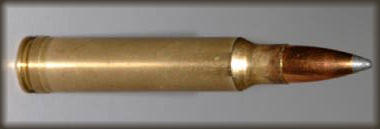

 The Accurate Reloading Forums
The Accurate Reloading Forums  THE ACCURATE RELOADING.COM FORUMS
THE ACCURATE RELOADING.COM FORUMS  Rifles
Rifles  Medium Bore Rifles
Medium Bore Rifles  history of the 7.5x54 rimless
history of the 7.5x54 rimlessGo  | New  | Find  | Notify  | Tools  | Reply  |  |
| One of Us |
Just a little background on this fine cartridge... At the end of WWI, the French had probably the worst LA ( Light full Automatic rifle) of any combatant in that fracas (the Chauchard) which they built in at least 8 m/m Lebel, 8m/m Mauser, .303 British, and .30-06 chamberings. Overall battlefield use and effectiveness of the major LAs of the war ranked the German 08/15 #1, the Lewis gun #2, the U.S. Brownings #3, and the French Chauchard dead last (mainly because of its very poor accuracy and its great susceptibility to stoppages caused by battlefield crud getting into the action). The French were not and are not stupid. They realized they desperately needed to get a better LA into the hands of their troops, so immediately after the armistice they began work on designing and producing a good LA. It was already apparent that using rimmed cartridges in a new LA would not be a good choice for a number of reasons...design simplicity of magazine and feeding mechanisms ,and dependability in the field being primary concerns. So, they decided to very slightly alter the specs of the already well known Swiss 7.5x55 rimless round, and designed their new LA around that...the 7.5x54, 1/2 m/m shorter cartridge case, and using a 140 grain BT spitzer cup 'n core.308 diameter bullet at about 2,780 fps. The results were 1) the very successful LA the 1924 Chatterault, which remained the primary French LA for decades, and 2) the adoption of the new 7.5x54 as their primary service round for both rifles and LAs. (An Aside.... the French were very, very close allies with the Czechs...to the point that the Czechs manufactured a good many of the Chatteraults issued to French troops in the 1920s. In 1926, the Czechs began selling the same gun world wide in 8m/m Mauser, calling it the ZB 26. One of the major buyers was China, which used it primarily against Japan. Later the Brits adopted it as their primary LA, changed the chambering to .303 British, and called it the Bren Gun. So in WWII the French, British Commonwealth countries, Czechs and some others were all using the same LA, though in 3 different chamberings under 3 different names. But the 7.5x54 was the original cartridge for that well known and widely favored LA.) With power almost exactly half way between the 7.62 NATO and the .30-06, it is also a very good sporting round currently available (for CHEAP!) all over the U.S. in MAS36 surplus rifles. My country gal's just a moonshiner's daughter, but I love her still. | ||
|
| one of us |
Thanks for the history! sputster | |||
|
| One of Us |
Old age is a high price to pay for maturity!!! Some never pay and some pay and never reap the reward. Wisdom comes with age! Sometimes age comes alone.. | |||
|
| one of us |
Thanks AC. I have owned and shot MAS 36s and a 49/56 in this caliber, and found it very pleasant and capable. (Also learned the hard way to use mil-spec primers in the 49/56!) There is hope, even when your brain tells you there isn’t. – John Green, author | |||
|
one of us |
Actually, the name is "Châtellerault". André DRSS --------- 3 shots do not make a group, they show a point of aim or impact. 5 shots are a group. | |||
|
| one of us |
AC Interesting article. According to "Cartridges of the World" the French developed the new machine gun in calibre 7.5x58 MLE1924C in 1924. There seems to have been confusion between this round and the 7.92x57 so in 1929 they shortened the round to 54 mm and made the case slightly larger in diameter. This became the 7.5x54 MLF1929C . | |||
|
| One of Us |
Interesting history. Does this mean the French and Swiss rounds will interchange? Years ago (about 50) I ordered a die set from RCBS for the 7.5 Swiss and they sent a 7.5 MAS for the size die. Jerry Liles | |||
|
| One of Us |
I believe CW is mistaken. My country gal's just a moonshiner's daughter, but I love her still. | |||
|
| One of Us |
Jerry - No, they are not safely interchangeable. The 7.54 French can be fired in the 7.5x55 (and is even pretty accurate), but there is really too much excess headspace for that to be safe. I have shot some of the 7.5x54 in my Swiss K-31 7.5x55, but only a very few. Brass came out "not nice" looking, and primers were really mashed where they had started back out of their pockets, then were shoved back in as the case head hit the bolt face full force. A weak or flawed primer cup could give one a face full of gas and debris. | |||
|
| one of us |
The two rounds are not interchangeable. The Swiss brass dimensions are too large.
I am a little doubtful that the French round developed totally from the Swiss cartridge. External brass dimensions and shoulder placement make it a virtual 6.5 x 55 Swedish Mauser variant. The French may have selected the 7.5 caliber from the Swiss, but I suspect the brass was from the Swede. Both have .480 rims and identical taper. In fact, if you run a 6.5x55 case thru a 7.5 French forming die, it merely expands the neck and shortens it to 54 mm. I know because that's how I made brass for my MAS36 before it was commercially available. Swiss brass is .495 at the rim with a wider body and different taper. It won't function thru a MAS36. | |||
|
| One of Us |
I am taking some of this information from a European authority on automatic arms, who published a book on the subject in 1934. He says it came from the Swiss 7.5x55. Different authorities may have different opinions, but this guy was an authority of that time. He published his book in '34, but had been noted in that field since during WWI. He may have had a little closer view of things than more recent writers. | |||
|
| one of us |
Not sure where CW gets their information . Anyone care to comment on this? | |||
|
| one of us |
Do a web search on "7.5x58 MLE 1924C " There are a number of sites,including Wikipedia that talk of the 7.5x58 being developed in 1924 and that it was changed to the 7.5x 54 in 1929 due to the similarities to the German 7.92x57 round. Strange that all those sites would be mistaken. | |||
|
| One of Us |
As an historian by training I'd not be unsurprised if they were. A lot of websites, shooting ones too, just repeat what they've read elsewhere. So the same error gets repeated often enough that it gets a truth all of its won. Here's one: US sites, and some Brit sites say that the "cut off" on the SMLE rifle was for single loading in aimed fire so that the full magazine could be kept in reserve for rapid fire. This is a total nonsense. Now it works as if you could do it that way, and yet it was never intended for that. British fire orders are such, and were such, that after the command "LOAD" was given that it was the individual soldier's responsibility in combat to keep the rifle loaded until the order "UNLOAD" was given. There is NO fire order, ever, concerning swinging the cut-off into or out of the position that it blocks the magazine. Now that in itself but LAZY authors have never bothered to research this from original source documents or even contemporary verbal histories. They just repeat what mistaken information they have read elsewhere. Now, at one time, twenty plus or of them or so, I had all of the British Army Small Arms Manuals from 1909 up to 1952 when the SMLE finally "falls out" of them. None advocate the "cut off" to be used as such and indeed the 1909 Manual specifically says that the "cut-off" IS NOT to be used in such a manner. It is there as a safety device so that the rifle may be inspected with the breech open and then slid across to stop ANY rounds being chambered when the order "EASE SPRINGS" is given. Yet LAZY authors repeat the wrong facts. So despite the talk about the 7.5x58 and etc. being repeated I'd want to see original source documents before accepting what Wikipeda quoutes as being true. It may be indeed true...but it may not. Whereas this seems well put together and does, indeed, seem to make use of primary sources. Supporting this idea of accidents with intermixing of the two nominal 57mm and 58mm cartridges: http://www.virdea.net/french/75.html | |||
|
| one of us |
No doubt a lazy researcher can spread some "un truths". So lets try to be objective about this. Every source that I find on line and in books seems to support the idea that the 7.5x58 was developed in 1924 and it was replaced by the 7.5x54 in 1929. If this is untrue why can't I find some evidence that the 7.5x 54 was developed in 1924?? And if the 7.5x54 was developed in 1924 what is the rest of the story about the 7.5x58?? Why was it developed? when ?? what happened to it? | |||
|
| One of Us |
Old age is a high price to pay for maturity!!! Some never pay and some pay and never reap the reward. Wisdom comes with age! Sometimes age comes alone.. | |||
|
| One of Us |
I remember a couple of people were trying to get Cartridges of the World, to either retract or modify their statements to get to the truth. One case in point was the 475A&M magnum, unsure of the exact name, it's a 460 Webbie necked up, which was touted to hurl 500 grain projectiles at +/- 3000 FPS. Not even the greater capacity 470mbogo is capable of such a feat, safely. Yet CotW continues with there obvious false reality. | |||
|
| One of Us |
| |||
|
| One of Us |
Yet people still revolve falsifications as fact. This is why I like A.R. Guys like you,ALF and many others have a wealth of knowledge. | |||
|
| Powered by Social Strata |
| Please Wait. Your request is being processed... |
|
 The Accurate Reloading Forums
The Accurate Reloading Forums  THE ACCURATE RELOADING.COM FORUMS
THE ACCURATE RELOADING.COM FORUMS  Rifles
Rifles  Medium Bore Rifles
Medium Bore Rifles  history of the 7.5x54 rimless
history of the 7.5x54 rimless

Visit our on-line store for AR Memorabilia

